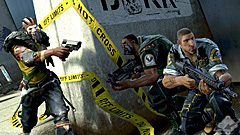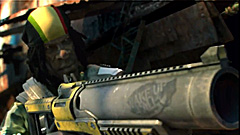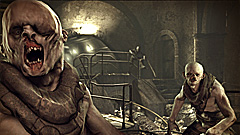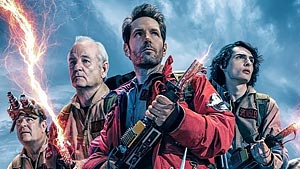May 15, 2011 by Paul Curtin


Any time that you go against the status quo and try to make big changes to a system that already works, you’re going to upset people who don’t like change. And when you use taglines for your game like “evolution” and “revolution”, you’ve got some big shoes to fill. Splash Damage’s Brink sets out to redefine not only first-person shooter gameplay mechanics, but the entire way that multiplayer gaming works, by combining single-player and multiplayer modes and allowing players to fight on either side of 8 vs. 8 battles.
On paper, Brink sounds brilliant, and it is. Splash Damage has created a truly unique experience that blends together gameplay mechanics from many successful games like Team Fortress, Killzone, and Mirror’s Edge. The problem with Brink is that while it successfully creates a mash-up of the three, it fails to improve upon anything that the previous games have done. While combining the three game types together into one well-made game is a feat in itself, it leaves you wondering how much better the game could have been if certain aspects were improved and more features were added.

The biggest problem with Brink is the execution of merging the single-player and multiplayer into one game. Whether you decide to play single-player or multiplayer, you’re going to be playing the exact same game, just with either real people or computer bots as teammates and enemies. Obviously, you’re going to rather be playing with people online; it’s more fun and you can always have better communication and teamwork with real live people. So there’s really no point in playing single-player with bots that can sometimes drive you furious as they stand around not contributing anything to the action. The only benefit of playing single-player is that you can watch the cutscenes and understand the plot better. You can also watch the cutscenes before a multiplayer match starts, but while you’re wasting time watching scenes about the plot, the actual game is going on without you. Basically, when playing multiplayer, you’ll want to jump right in to help your team and win; however, you’ll be playing a plot-driven objective game and really have no idea what the hell is going on.
Even if you decide to screw your team by watching cutscenes instead of jumping right into the action of a multiplayer game, or decide to play the single-player by yourself to get the full story in chronological order, you won’t be treated to an actual story. Instead of a real story, you’ll just see a short minute-or-two cutscene before every game that really offers nothing in terms of story or character development — it’s a system that Lost Planet 2 used and received a lot of negative feedback for doing, so I’m not sure why Splash Damage decided to use this style.
Killzone 3 is a good example of how Brink could have done things the right way with single-player and multiplayer being separate game modes, but with multiplayer featuring different deathmatch and objective-based modes. One of Killzone‘s multiplayer modes allows players to compete in story-based objective games that aren’t heavy on the plot, but still involve players’ characters throughout the current game in various cutscenes as they complete important objects. Brink really only offers one multiplayer mode from Killzone 3 and tries to pawn it off as a full game.

But enough about the lack of story; let’s talk about the actual gameplay, which is what Brink is all about and sets it apart from most shooters on the market. Each level available to play in single or multiplayer mode features different missions with one team attacking and the other defending. If the attacking team is successful in completing the first main mission, then a second area of the map opens, time is added, and a new mission starts. Each map has about four main missions that involve tasks such as planting C4 to blow up a door, hacking a computer to gain information, or escorting a person or vehicle from point A to point B. Each level (map) can be played from the attacking or defending side, which helps add replayability and makes it seem like there are more maps than there really are.
While there are tons of other video games with these types of objective-based game modes already out there, some of which even do a better job than Brink, the aspect of working together as a team is where Brink‘s gameplay shines. There are four different classes: Soldier, Engineer, Operative, and Medic — all of which give players the ability to choose their roles based on individual preference or a team’s current requirements. Different classes also have special class-based buffs that they can apply to themselves and others like increased weapon damage or increased health. Buffs play a vital role as they can be stacked if you have a good team willing to constantly throw them out and can make you much stronger than your potentially unbuffed enemies.
Each game also has a set of primary and secondary objectives which players can pick from at any time and require a certain class to complete. Some objectives are harder than others and require players to work together in order to achieve success, but the harder missions are worth the reward as they can be the difference between winning and losing a game by giving teammates alternate routes and health buffs. Players can also change their class at any time during games in order to fill in whatever class a team might be lacking by visiting command posts that can be found throughout the map.

Unlike most shooters on the market today that only allow for little to no customization, Brink starts out by allowing a player to fine-tune the size and look of their character by selecting from a wide range of body types, skin tones, hair styles, tattoos, and even allowing for a different clothing item to be selected for each body part, such as shirts, pants, and face masks. Certain options are purely aesthetic; however, others like body type (small, medium, large) affect a character’s strength, speed, and even weapon repertoire. Smaller characters can jump to higher areas of the map that bigger guys can’t, while big guys can take far more damage. There’s a full arsenal of different guns, each of which have multiple slots that can be customized with add-ons like silencers, scopes, and extra magazines. The only problem is that many guns look and feel the same. It would have been nice if there was more diversity in the functionality of each weapon.
Brink also gives players an upgrade system full of talents to choose from which improve and expand gameplay (think Call of Duty perks mixed with Bioshock’s upgrade system). Some talents seem more useful than others, like the ability to keep shooting after being taken down but not killed (similar to Call of Duty‘s Last Stand perk), a camera angle switch to 3rd person for a superior view in certain situations, and stronger health packs that medics can dish out to other players for revival. While the revive ability is not new to video games, Splash Damage has improved the system by allowing players who are being revived by a medic to choose whether they want to get up or respawn back at the base, thus eliminating the exploit opportunity and/or stress created in other games where assholes and stupid players constantly revive you in the middle of fights, just to be gunned down time after time, ruining the fun and spoiling the competitiveness of the game.
There are many features that make Brink stand out from the rest, but the most impressive is an optional traverse system called “S.M.A.R.T.” or “Smooth Movement Across Random Terrain” that works like the free-running controls in Mirror’s Edge but simpler and more fluid. By simply holding down one button, the character will start to sprint and when approaching an obstacle, S.M.A.R.T.’s autopilot takes over and allows players to vault over obstacles and climb up walls. But don’t think this is like other games where vaulting over barriers or climbing walls triggers canned animations, because Brink‘s S.M.A.R.T. system allows for all of this to happen in real time while the player is still in control. If anything is “borrowed” from Brink by other developers, it’s sure to be this feature. I haven’t played another FPS since Brink, but I’m sure I’ll be asking where my “S.M.A.R.T.” button is when I do.

Brink reminds me of an older game that came out back in 2007 called Shadowrun. Both games required strong teamwork, were highly anticipated, and had so much potential, but for whatever reason, neither were able to live up to the hype and felt somewhat incomplete. Like Shadowrun, Brink is a lot of fun to play, but it’s hard to justify paying $60 for a game that doesn’t feel like a full game and more of an online experience with only one mode.
I would have liked to see Brink add in the ability to only play a certain type of multiplayer match like Deathmatch. While I prefer objective-based games, I know a lot of people who just like to play straight Deathmatch and who will be turned away from the idea of Brink when learning they’ll have to play different game modes. Even with Brink falling well short of evolving the FPS genre, it’s a good enough game to make noise that could start a revolution and be responsible for a lot of the changes we’ll see in the future of FPS games. Brink gets 3 out of 5 stars. (Good)
The Pros
- Beautiful graphics that run smoothly during chaotic battles
- Tons of different character, weapon, and skill (perk) customization options
- Multiple classes with unique skills and abilities
- Objective-based games that actually require real teamwork
- “S.M.A.R.T.” free-running system is a great addition that makes FPS gameplay more fun
The Cons
- Single-player and multiplayer are the exact same, making single-player pointless
- Lack of multiplayer modes make the game feel incomplete
- Most guns feel the same and will have you confused when trying to decide which is actually the best
- Occasional massive lag spikes that can make multiplayer unplayable














